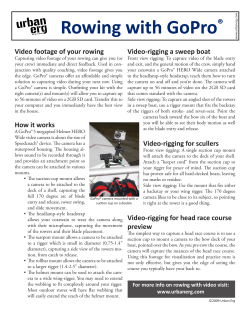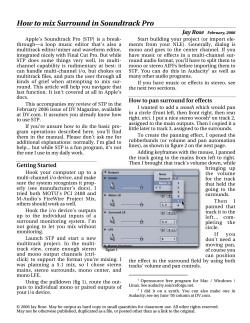
! How to Take Single Digital Camera 3D Photos
! How to Take Single Digital Camera 3D Photos! Extract of an item by Ray Moxom from the January 2007 issue of 3D Window, the Bulletin of the Sydney Stereo Camera Club Taking 3D Photos with a Single Digital Camera by Ray Moxom 3D photography relies on two images being taken of the same subject from slightly different viewpoints, just as our left and right eyes see 3D due to the separation of our eyes. This article will describe three simple methods of taking digital 3D photos of stationary subjects using any digital camera. The methods described below can be categorised as: Slide Bar 3D, Body Sway 3D and Large Camera Movement Hyper 3D. Slide Bar 3D A slide bar is a device that allows the camera to be moved sideways between exposures while remaining at the same level for each shot. Camera shops tend to call the device a focusing rail, as in 2D photography it can be used to move a camera closer or further away from the subject. The photo above shows a compact digital camera set up for taking 3D photos using a slide bar. The photo on the right shows the movement of a Digital SLR (DSLR) on a slide bar as multiple images are being taken. a guide to making 3D images with any standard digital camera www.oz3d.info The common practice for slide bar 3D photography with film is to measure the camera to subject distance and then move the camera about one thirtieth to one twentieth of that distance between exposures. Digital is much easier as it allows us, at no cost, to shoot multiple exposures while moving the slide bar across the plane of the subject. The best stereo pair is then chosen during the image editing process. Large Camera Movement - Hyper 3D Single digital camera hyper stereos are taken from high and/or distant viewpoints such as from an aircraft, a hill top, the top of a tall building or even from a moving car, ship or train. Again digital can sometimes have a big advantage as it allows us to shoot multiple exposures and then select the best stereo pair and discard the rest. Any digital camera can be used when the time between exposures can be delayed, such as shooting from the top floors of a tall building, where you take a shot and then keep stepping sideways between successive shots. However, not all digital cameras can make multiple exposures at high speed – for this you are likely to need one of the newer DSLRs. In the Canon range their 400D and 30D are excellent for shooting aerial hypers. The Canon EOS 30D DSLR can take 30 consecutive shots at 5 frames per second and the Canon EOS 400D DSLR can take 27 consecutive shots at 3 frames per second. The above stereo image by Nancy Moxom was taken with a DSLR and a slide bar. The photo was taken indoors against a black background. The flower was lit using three tungsten photofloods. Exposure was ¼ sec at f16 with ISO set at 100. The camera was a Canon EOS 300D digital SLR with a 100mm lens. Five images were taken and shots 2 and 4 selected as the best stereo pair. Body Sway 3D (Cha-Cha) The technique here is to keep the camera level while changing the body weight from one foot to the other thus shifting the camera position across the plane of the subject while shooting. Again digital is much easier as it allows us to shoot multiple exposures and later selecting the best stereo pair and discard the rest. I took the above fungi photo using the Cha-Cha method with a Canon EOS 300D DSLR while walking in Tasmania’s Styx Valley. Exposure was 1/50th sec at f5.6 with ISO set at 1600. Six shots were taken – the selected pair were 3 shots apart. Also, have a look at Bert van Aken’s Digital Cha-Cha shots of the Australian National Gallery Sculpture garden on page 7. Page 3 Sydney Stereo Camera Club Inc I took the above aerial hyper at Hill Inlet in the Whitsundays from a helicopter using a Canon EOS 30D DSLR. Exposure was 1/250th sec at f13 with ISO set at 250 and the 17 to 85mm zoom lens set at 26mm. The selected pair were 7 shots apart from a sequence of 25 shot at 5 frames per second. The above hyper of the Sydney Opera House was taken from the top deck of the Spirit of Tasmania as we were returning home from a Tasie holiday. Camera was a Canon EOS 300D DSLR with the zoom lens at 42mm. Exposure was 1/125th sec at f16 with ISO set at 100. Adjacent pairs were selected from a sequence of 4. Page 4 Sydney Stereo Camera Club Inc Editing and Printing Your Digital 3D Images The topic of editing and printing digital 3D images really deserves a more detailed discussion than I am including here. Depending on the interest, we may publish more on this topic in the future, perhaps including techniques for producing anaglyphs. Some computer skills with the type of photo editing software that is often included with digital cameras and scanners is useful, however these skills can be learned. A downloaded copy of the free ‘Stereo Photo Maker’ software from http://stereo.jpn.org/eng/stphmkr/ will simplify the production of stereo pairs or anaglyphs. The latest version, when I was writing this article, was 3.10a, which is a 7Mb download. The 3D windowing information in the Club’s mounting guide (3D Window No 179) also applies to the editing of your digital stereo pairs for printing. The simplest and cheapest method of printing stereo pairs is to edit your 3D images to the standard 15cm x 10cm (6”x4”) photo size and take the edited files on a memory card to one of the discount photo labs such as Teds, Harvey Norman or Domain where standard prices are about 30 cents per print. These prices are frequently discounted by up to 50% in their catalogues and/or on selected days of the week. At the time of writing Domain at Auburn had a 2 for the price of 1 special for all sizes of prints on every Tuesday and Harvey Norman at Auburn had a half price special for 6”x4” prints on every Thursday. Standard 6”x4” stereo cards are ideal for viewing in the low cost, but well made, Loreo viewer (photo p 8). each layered over the same ‘mono’ digital cloud shot and the original black background was then selected and deleted to reveal the clouds. When you have your edited digital 3D image files, there are several options for viewing and sharing your images other than making side by side 3D prints. One option is to produce digital 3D files for viewing on the computer screen, emailing to friends, posting to websites and for entering into the several 3D digital competitions that now exist. Another option is to make Anaglyph prints for viewing with the Red-Cyan glasses that the Club sells for $2. A further option is to ‘print’ to slide film using either a film recorder or by photographing the computer screen. Film recorders are now cheap to buy on eBay and three SSCC members (2 in Melbourne and 1 in Sydney) now have there own film recorders. If there is sufficient interest, film recorders may be the topic of a future 3D Window’s article. Which Digital Camera is Best for 3D? Great 3D shots can be taken with relatively low cost compact digital cameras such as the Canon A530 as advertised in Ted’s Jan 2007 Catalogue for $210. This is a 5Mp camera that has 4x optical zoom and full auto or manual control. Ted’s also had the excellent 10Mp Canon EOS 400D digital SLR with an 1855mm zoom lens for $1,259. Teds (www.teds.com.au) have moved into the old Fletchers Pitt Street store and have a special of half price prints for 3 months with all digital camera purchases. Canon A530 (above) and Canon EOS 400D (right) The camellia in the 6”x4” stereo card above was originally taken indoors against a black background. The flower was lit using tungsten photofloods. Exposure was ¼ sec at f16 with ISO set at 100. The camera was a Canon EOS 300D digital SLR with a 100mm lens. Several images were taken and the best 3D pair selected for editing. In a photo editing program, the left and right camellia shots were Page 5 Sydney Stereo Camera Club Inc Digital SLRs have physically larger sensors than compact digital cameras. For top quality 3D digital images, particularly if the aim is to make slides from digital images, a DSLR with its larger sensor and almost instant warm up time has many advantages, but at a considerable increase in cost. In digital photography the physical size of the sensor can be more important than the number of megapixels. It is better to have a larger sensor, even if the number of megapixels is smaller, than to cram more megapixels into smaller sensors. Page 6 Sydney Stereo Camera Club Inc Digital Cha-Cha with Bert Below are three digital stereo shots taken Cha-Cha method by Bert van Aken with a compact digital camera. The photos were taken at the Australian National Gallery Sculpture Garden that we visited during our Canberra 3D Weekend in September. See the Cha-Cha item on page 3. The Loreo 3D Viewer shown on the right and above with 6”x4” stereo prints, is an easy to use 3D print viewer available online from the Hong Kong maker at www.loreo.com for US$24 plus US$10 postage. The viewer is now sold as a Dark Grey Deluxe 3D Viewer and as a Multi-Coloured Deluxe 3D Viewer Page 7 Sydney Stereo Camera Club Inc Page 8 Sydney Stereo Camera Club Inc
© Copyright 2025



















